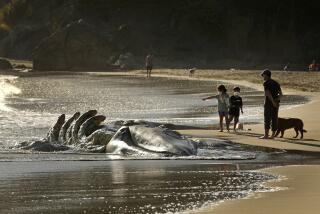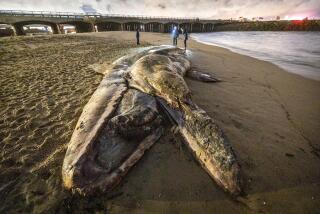Like a tree’s rings, blue whale’s earwax tells a story of its life
- Share via
Scientists probing a giant plug of earwax pulled from a dead blue whale have discovered in its hardened layers a detailed biography of the wild animal’s life, from birth to death, in 6-month chapters.
Their new technique, described in the Proceedings of the National Academy of Sciences, arms researchers with a tool to understand a whale’s hormonal and chemical biography -- and a window into how pollutants, some long discontinued, still pervade the environment today.
Whales are often called marine sentinels because they can reveal a lot about the waters they pass through, said study coauthor Sascha Usenko, an analytical environmental chemist at Baylor University in Waco, Texas.
“These types of marine mammals that are long-lived have a great ability to accumulate contaminants, and so they’re often perceived as being sentinels of their ecosystem,” Usenko said.
Researchers often study tissue and even whale blow (the stuff they exhale from their blowholes) for chemical clues. But for the most part, blubber, or fat tissue, reveals just the whales’ total accumulation, said Gina Ylitalo, a research chemist with the National Oceanic and Atmospheric Administration based in Seattle who was not involved in the study. It doesn’t really give scientists a play-by-play account of the animal’s chemical exposure or hormonal production over time.
But Usenko realized that earwax is rich in lipids, just as fat is. So the same lipid-loving hormones and chemicals found in a whale’s insulating blubber would also end up in its ear canal.
He also knew that as the wax is deposited in the ear over time, it forms a plug whose layers can be counted like tree rings to determine its age.
But he wondered if scientists could do more than just count the waxy layers. What if they could read each one, too?
“If I could section out each one of those layers and perform an analysis of each, then I could understand not only what they were exposed to today, but go back in time,” said Usenko, who was used to studying ice and sediment core layers to understand an area’s environment over time.
To test this theory, the team took a very fine-toothed band saw to a 10-inch earplug pulled out of a nearly 70-foot-long male blue whale (Balaenoptera musculus), that died after a 2007 collision with a ship off the Santa Barbara coast.
“It’s naturally pretty heavy and strong and resilient,” Usenko said of the wax, which is mostly made up of keratin (the stuff in hair and nails) and lipids. “It doesn’t necessarily smell great.... When we were pulling it out, some of the crew actually just left.”
The plug’s 24 layers are laid down in light and dark stripes, Usenko said. The lighter bands are more rich in lipids and thought to result from periods of abundant food, while the darker parts may be a sign of leaner times.
They found that the whale’s testosterone levels spiked 400-fold around 10 years old -- a mark that it had reached sexual maturity, refining researchers’ estimates of when males come of age.
Levels of the stress hormone cortisol spiked 800% shortly after the whale’s testosterone shot up -- a sign that the stress hormone’s rise could be due to competition for mates.
The average concentrations of cortisol also doubled over the animal’s lifetime, which could be due to any number of factors, including food availability, changes in social status, contaminant exposure or environmental noise, the authors wrote.
While the hormones in the ear wax gave scientists a look at the whale’s personal biography, the chemical contaminants found -- from flame retardants, pesticides and other pollutants -- also opened a porthole onto humans’ long-term effects on the ocean.
The researchers found several persistent organic pollutants in the whales’ bodies, particularly DDT, the insecticide largely banned in the U.S. in 1972 in part for its suspected cancer-causing properties. But this whale had been born after the chemical’s use was discontinued.
In fact, a full 96% of the total burden of organic pollutants in its wax came from four historic-use pesticides (and their metabolites) and a PCB, a type of chemical used in coolants and insulating fluids.
Many of the pollutants in the whale’s ear plug, particularly the discontinued chemicals, were probably passed through its mother’s milk, Usenko said. Persistent pollutants spiked in the baby whale’s first 6 months, a period that accounted for 20% of the total persistent pollutants over the whale’s 12-year lifespan.
The researchers saw peaks in mercury too, one when the whale was about 5 to 6 years of age and again when it was about 10 years old. Because the whale seemed to travel up and down the California coast, perhaps it was swimming through regions with increased mercury contamination, the authors wrote.
“I thought it was a novel idea, to be looking at contaminants at those different time points,” Ylitalo said. “It’s a neat little way to get that information.”
[Updated, 11:15 a.m. PDT, Sept. 18: One of the great challenges of studying large whales is collecting samples from them in the field, said Randall Davis, a comparative physiologist at Texas A&M University who was not involved in the study. This new method would allow them to pull a rich array of information from earwax samples already sitting in museum collections.
“The lifelong archive of contaminants and hormones,” Davis said in an email, “is unprecedented and has great potential for providing new information on the endocrinology and toxicology of these animals. I know of no other method to obtain this type of information.”]
Usenko said he planned to study more whales’ earwax, and perhaps examine the earwax of other species of whales, too.
“It gives us a lot more opportunities and a new way of asking questions and getting answers,” Usenko said. “That’s really exciting.”







